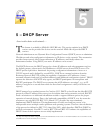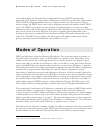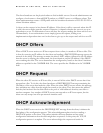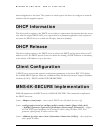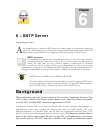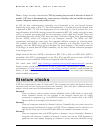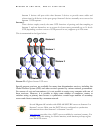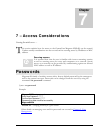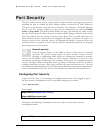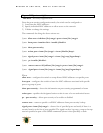
MAGNUM 6K SWITCHES, MNS-6K USER GUIDE
Time or Temps Atomique International (TAI) by inserting leap seconds at intervals of about 18
months. UTC time is disseminated by various means, including radio and satellite navigation
systems, telephone modems and portable clocks.
In 1981 the time synchronization technology was documented in the now historic Internet
Engineering Note series as IEN-173. The first specification of a public protocol developed from
it appeared in RFC-778. The first deployment of the technology in a local network was as an
integral function of the Hello routing protocol documented in RFC-891, which survived for many
years in a network prototyping and test bed operating system called the Fuzzball. There was
considerable discussion during 1989 about the newly announced Digital Time Synchronization
Ser-vice (DTSS), which was adopted for the Enterprise network. The DTSS and NTP
communities had much the same goals, but somewhat different strategies for achieving them.
One problem with DTSS, as viewed by the NTP community, was a possibly serious loss of
accuracy, since the DTSS design did not discipline the clock frequency. The problem with the
NTP design, as viewed from the DTSS community, was the lack of formal correctness principles
in the design process.
Simple Network Protocol (SNTP) is described in RFC-1769 as well as in RFC-2030. SNTP is
compatible with NTP as implemented for the IPv4, IPv6 and OSI protocol stacks. SNTP has
been used in several standalone NTP servers integrated with GPS receivers.
The article from NIST http://tf.nist.gov/timefreq/service/pdf/computertime.pdf provides
details on time synchronization services as well as ports time synchronization services need to
communicate on. http://physics.nist.gov/GenInt/Time/time.html provides a walk through the
history of time and time synchronization on the NIST site. There are many other interesting
articles available on Internet.
Stratum clocks
NTP uses a hierarchical system of "clock strata". The stratum levels define the distance from the
reference clock and exist to prevent cycles in the hierarchy. (Note that this is different from the
notion of clock strata used in telecommunications systems.)
Stratum 0
These are devices such as atomic (cesium, rubidium) clocks, GPS clocks or other radio
clocks. Stratum-0 devices are not attached to the network; instead they are locally
connected to computers (e.g. via an RS-232 connection.) The atomic clock at the NIST
Denver facility is an example of the Stratum 0 clock.
Stratum 1
These are computers attached to Stratum 0 devices. Normally they act as time servers for
timing requests from Stratum 2 servers via NTP. These computers are also referred to as
time servers. Time servers from NIST and USNO are examples of Stratum 1 servers.
Stratum 2
These are computers that send NTP requests to Stratum 1 servers. Normally a Stratum 2
computer will reference a number of Stratum 1 servers and use the NTP algorithm to
gather the best data sample, dropping any Stratum 1 servers that seem obviously wrong.
85



